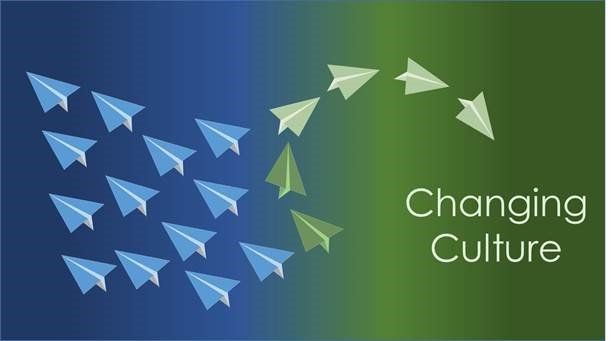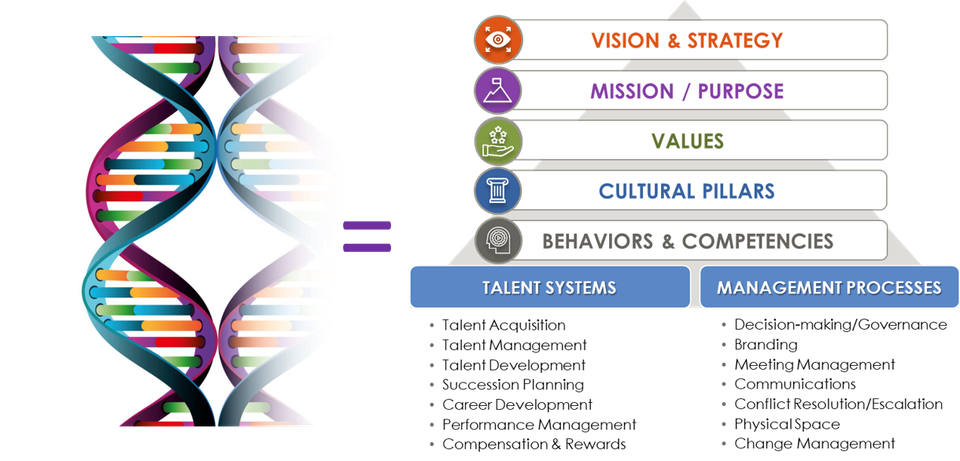The Secret to Changing Culture is in the Genes
We have supported a broad spectrum of companies in various industries in their efforts to identify and shape cultural change. There are some striking similarities emerging. In the face of seismic shifts in the competitive landscape, digital transformation being one, for many clients and the industries in which they play, there is a fairly common cluster of aspirational cultural features that have emerged. But in addition, what is almost universal is the degree of difficulty of actually making any change stick. This is true, despite everyone going through a common process to define a desired culture that will serve the organization’s vision and strategy, while honoring its coveted mission/purpose and values.
The difficulty of successfully implementing change is itself quite troubling. We believe one reason for the lack of success in so many organizations is the tendency to simplistically want to follow a common set of proscribed “best practices” around culture change. This is the classic “one size fits all” mistake that fails to take into consideration the unique combination of characteristics that make every organization different. Every organization has its own unique set of genes. That specific combination of genes forms unique challenges and opportunities.
In the field of medicine, until recently, the widely held opinion was that everyone responds to prescription drugs pretty much the same. Medical research now provides evidence that, due to our genetic map, we all metabolize prescription drugs differently. The fact of the matter is that people experience a wide range of possible effectiveness and/or unintended side effects . And with gene research, now we can even pinpoint specific genes that account for various differences. This knowledge is enabling a more refined practice of “personalized medicine.”
Changing culture is far from medical science, but the same principle applies: the effectiveness and/or unintended side effects of change efforts depend in part upon the unique genes in the organization. It is too easy to just peg an organization into a pre-set classification of culture type. Of course, we also know from medicine that environmental surroundings and an individual’s lifestyle choices are critical in determining their health. The same can be said for the culture of an organization. It is important to understand the context–the history of a company, the industry in which it operates, its stage of growth/development, geography, size, the nature of external relationships, etc.
But like human beings, no two companies will react exactly the same in the same environment. What is more effective is to approach each organization as unique – or “personalized” – looking to capture their unique DNA or “secret sauce.” This consists of some combination of their keystone of culture; their strategy, mission/purpose and indelible values. And it includes a sense of “how work gets done,” meaning how they are organized, their guiding principles/work practices, and accepted behaviors; this includes meeting practices, modes of communications and governance/decision making patterns. All of this, and more. We need to understand the interplay between this unique DNA and the environment.
For sure, it requires additional effort and thoughtful reflection. But that knowledge is important, especially in the face of so many failed attempts to change (or integrate, in an M&A/JV) culture. It is the holistic alignment of multiple perspectives and factors in the organizational system – from vision and strategy to mission and values to behaviors/competencies – that uncover the genetic composition unique to each organization. This unique genetic map needs to be assessed in the context of the challenges faced in its surrounding environment.
From this more deeply informed perspective, more nuanced approaches to finding the most effective points of leverage can be determined to initiate and drive change. It may have to do with new talent development programs. Or a stronger succession planning process, more rigorously pursued. Or a different approach to how leadership decisions are made across the organization, or between specific functional or geographical units, or in very precise pain points of customer support. Or in the composition of the performance management and reward system. Or to drive a better employee experience, where leaders need to create a more inclusive culture for all employees to bring their whole selves to work and contribute the best they can.
This is not only a matter of selecting where to start to initiate the greatest momentum shift, but when and how : the timing and sequencing of a series of follow-up measures and steps to reinforce change over time. As for the “ who,” at the very least we know it requires leadership; that is a given, and that is where we start.
And as much as we might like culture change to be easy and formulaic, our experience has shown that is it not. In the face of industry disruption (e.g., digital, globalization, consolidation), an organization’s ability to change is absolutely critical. Our advice to leadership is that it is worth the time and effort to do this right. The cost of not doing so is much greater.













